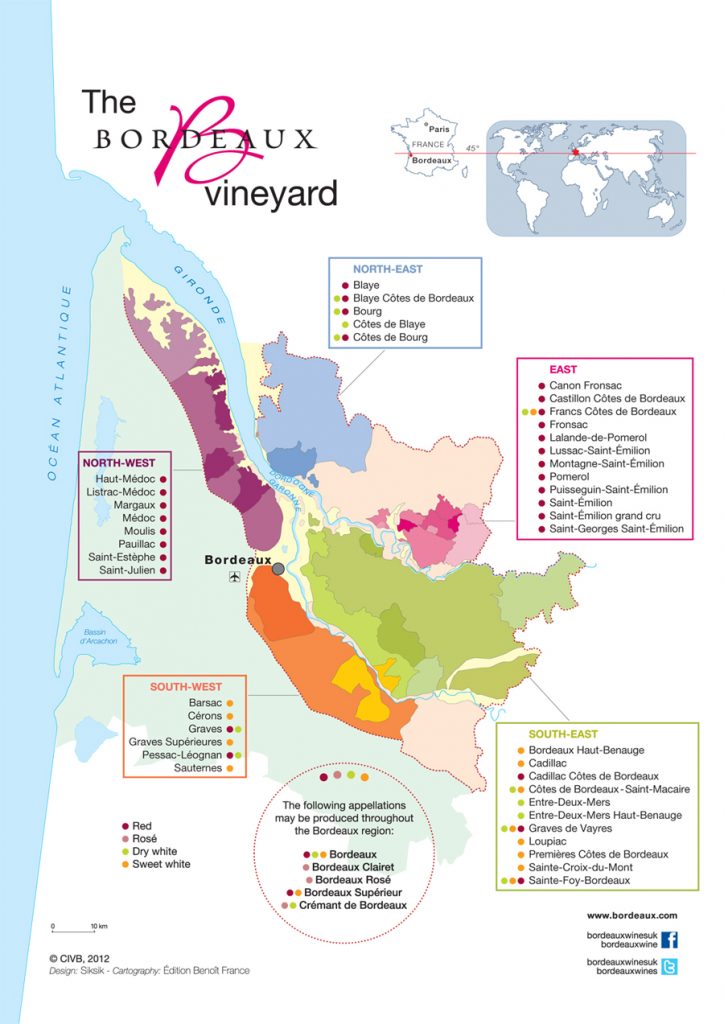Gilles & Phillipe Reich at Château Aimée in Bégadan – Médoc
David Arnaud, at Château Tour des Graves in Teuillac, Côtes de Bourg
David Latorse at Château Gabaron in the Entre-deux-Mers
- Château Gabaron Blanc Bordeaux « Sauvignon Blanc » 2022
- Château Gabaron Rouge Bordeaux « Cabernet Sauvignon » 2019
- Château L’Ombrière Bordeaux Supérieur 2019
Clos Saint Vincent, Saint Émilion – Libournais
Jean-Yves Millaire in Fronsac & Canon-Fronsac (Certified Biodynamic)
Francis & Françoise Desqueroux in the Graves & Sauternes
More about Bordeaux…
Left bank vs Right bank… and how about the Entre-deux-Mers too
To understand Bordeaux (Bord – along & eaux – waters) you have to know that it’s organized around the two rivers Dordogne in the North and Garonne in the South, these two meeting up at the door of the city of Bordeaux creating the Gironde estuary.
These rivers split Bordeaux between three major areas literally designed by the river flow.
The Right bank, in the north, with its clayous and chalky Terroir, is the kingdom of Merlot. Here the Libournais is the center of interest, with appelations like Saint Emilion, Fronsac or Pomerol.
The left bank, or the southern side of the rivers, formed the gravely terraces of the Gironde estuary is the kingdom of Cabernet Sauvignon.
This division is divided into two sections:
* The Graves region in the southern end, district that includes the Sauternais and Pessac-Léognan the more distinguised vineyards of the area.
*The Medocain with Medoc in the northern end and Haut-Médoc below it, the latest being what made Bordeaux a legendary vineyard with villages like Pauillac, Saint Julien or Margaux to name just a few.
Lastly, the third Bordeaux district is called Entre-Deux-Mers (Between-two-seas) which lies between the Dorgogne and Garonne. This vineyards made of rolling hills designed by the rivers, is the place where to find the value driven Bordeaux AOC, that you can find in red or white, or Entre-Deux-Mers AOC that is dedicated to white.
Dominant varieties.
6 noble red grapes
66% Merlot
22.5% Cabernet Sauvignon
9.5% Cabernet Franc
2% Malbec, Petit Verdot, Carménère
7 noble white grapes
47% Sémillon
45% Sauvignon Blanc
6% Muscadelle
2% Colombard, Ugni Blanc, Merlot Blanc, Sauvignon Gris
Bordeaux vs Bordeaux Supérieur
To be classified as Bordeaux Superieur the wine is required to age in oak barrels for a minimum of 12 months. The wines will also have higher sugar levels therefore coming from lower yielding vines, than is commonly found in generic Bordeaux AOC wines.
Finally, the vast majority of Bordeaux Superieur wines are bottled at the estate, which is not required for the Bordeaux AOC.
To learn more about the Bordeaux Terroir https://www.bordeaux.com/us/Our-Terroir
Saint Émilion vs Saint Émilion Grand Cru
The Saint-Émilion appellation is one of the largest in Bordeaux covering 5,565 hectares of vineyards. This is divided further into a sub-division Saint-Émilion Grand Cru along with four satellite appellations: Lussac-Saint-Émilion, Montagne-Saint-Émilion, Puisseguin-Saint-Émilion and Saint-Georges-Saint-Émilion.
Confusingly, Saint-Émilion Grand Cru is not part of the Saint-Émilion classification; it is a geographical area also. The 600 or so estates which have the right to use Saint-Émilion Grand Cru, can come from the same area as the Saint-Émilion wines but they have lower yields and higher potential alcohol levels and are therefore considered of higher quality.
Médoc Cru Bourgeois Classification
The Crus Bourgeois are a legacy that dates back to the Middle Ages.
The bourgeois were inhabitants of the « bourg » of Bordeaux, a town of merchants and craftsmen. During the period of English rule, they acquired rights and privileges, including exemption from taxes on the sale of the wines from their vineyards both locally (Guyenne) and abroad.
By the fifteenth century, enriched by their international commerce, the bourgeois of Bordeaux were able to acquire the finest properties in the region, which were initially referred to as the « Crus des Bourgeois » and then simply the « Crus Bourgeois ».
The Crus Bourgeois form today a big family that brings together vineyards with widely differing profiles, and very different terroirs (eight prestigious AOCs : Médoc, Haut-Médoc, Listrac-Médoc, Moulis en Médoc, Margaux, Saint Julien, Pauillac and Saint Estèphe) Their certification and classification, is surely one of the stricter in the all Bordeaux Vineyard and is done on a yearly basis. Therefore, having it one year is no guarantee that you will have it the following year. The wines are assessed and certified on an annual basis by an external independent body. The current and latest classification list published is for the 2010 vintage. Only 260 wines received the Cru Bourgeois certification in 2010.
This category has become the most reliable classification of all Bordeaux vineyard and offer the consumer the best price for quality for vineyards that can often compete with the greatest of the Haut Médoc Châteaux.

